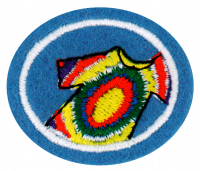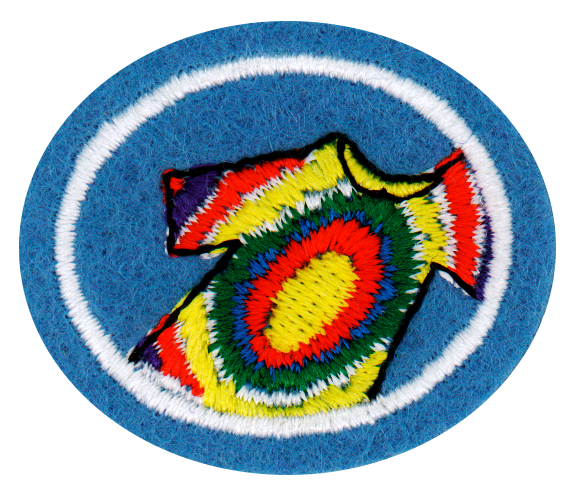Difference between revisions of "AY Honors/Tie-Dye/Answer Key/es"
(Updating to match new version of source page) |
(Created page with "</noinclude> <!-- 2. Saber cuál es el propósito de la soda comercial y cuánto tiempo debe ser remojada la tela. --> Sumergir la tela en una solución de carbonato de sodio...") |
||
| Line 16: | Line 16: | ||
{{CloseReq}} <!-- 1 --> | {{CloseReq}} <!-- 1 --> | ||
{{ansreq|page={{#titleparts:{{PAGENAME}}|2|1}}|num=2}} | {{ansreq|page={{#titleparts:{{PAGENAME}}|2|1}}|num=2}} | ||
| − | <noinclude> | + | <noinclude></noinclude> |
| − | </noinclude> | + | <!-- 2. Saber cuál es el propósito de la soda comercial y cuánto tiempo debe ser remojada la tela. --> |
| − | <!-- 2. | + | Sumergir la tela en una solución de carbonato de sodio prepara las fibras de la tela para una unión química permanente con el tinte utilizado en el teñido. La tela doblada y atada puede sumergirse en un baño de solución de carbonato de sodio durante 5-30 minutos. Luego se aplica tinte, ya sea sumergiendo el paquete de tela en un baño de tinte o aplicando colorantes en áreas específicas de la tela. Alternativamente, la sosa se puede agregar directamente a la solución de tinte en lugar de sumergir la tela en una solución de sosa. Después de 12-48 horas, dependiendo de la temperatura, el tinte y el brillo deseado del producto final, el tejido se puede enjuagar y desenvolver. |
| − | |||
| − | |||
| − | + | <noinclude></noinclude> | |
| − | <noinclude | ||
| − | |||
{{CloseReq}} <!-- 2 --> | {{CloseReq}} <!-- 2 --> | ||
{{ansreq|page={{#titleparts:{{PAGENAME}}|2|1}}|num=3}} | {{ansreq|page={{#titleparts:{{PAGENAME}}|2|1}}|num=3}} | ||
Revision as of 00:40, 11 May 2021
Nivel de destreza
1
Año
2006
Version
10.05.2024
Autoridad de aprobación
Asociación General
1
Los mejores tipos de material contienen al menos 80% de celulosa. Esto incluye:
- Algodón
- Rayón
- Lino
- Tencel (Lyocell)
Antes de teñir, el material debe lavarse y luego sumergirse en un baño de carbonato de sodio.
2
Sumergir la tela en una solución de carbonato de sodio prepara las fibras de la tela para una unión química permanente con el tinte utilizado en el teñido. La tela doblada y atada puede sumergirse en un baño de solución de carbonato de sodio durante 5-30 minutos. Luego se aplica tinte, ya sea sumergiendo el paquete de tela en un baño de tinte o aplicando colorantes en áreas específicas de la tela. Alternativamente, la sosa se puede agregar directamente a la solución de tinte en lugar de sumergir la tela en una solución de sosa. Después de 12-48 horas, dependiendo de la temperatura, el tinte y el brillo deseado del producto final, el tejido se puede enjuagar y desenvolver.
3
Urea helps to dissolve the dye. It also slows the drying process which allows the dyes to produce vivid colors.
4
At a minimum, an apron and gloves should be worn. Soda ash is somewhat caustic, so you do not want to get it on your skin or on your clothing. You should be aware that dye will color your skin and clothing as easily as it colors a tee-shirt.
5
The three primary colors for dyes are red, blue, and yellow.
6
Orange, green, and purple are called the secondary colors because they are each made by mixing two primary colors. To make Mix this and this
- Orange = Yellow + Red
- Green = Blue + Yellow
- Purple = Red + Blue
7
Mixing two secondary colors will produce a shade of brown. This is the same as mixing all three primaries (though it will not be an equal mix of the primaries).
8
Fold the tissue using one of the patterns describe below or make up your own pattern. Once the tissue has been folded, color it with a marker. Then unfold it to see the result.
Below is a list of common modern tie-dying folds and patterns.
Bullseye
Bullseyes involve a central point which is bound, as though poking the fabric with a finger or stick then binding the protrusion every 1-2 inches. Usually different color dyes are applied to each bound section to create rings of color.
Stripes
Horizontal or vertical stripes are created by pleating the fabric into several small folds, causing the dye to spread laterally. Horizontal pleats make vertical lines, and vertical pleats make horizontal lines.
Spiral
Spiral patterns involve pleats of fabric arranged in swirls around a central point, bundled into a round bun often resembling a cinnamon bun or a snail's shell. Different wedges of the circular bun are dyed different colors.
V
The 'V' shape achieved by folding a shirt in half vertically, then a line is drawn diagonally from the shoulder area down to the center fold of the shirt. The fabric is then accordion folded along the line and bound into one or more areas to which the dye is applied.
Random
This category can hold several different patterns, the majority of which have nothing to do with each other; they can be combinations or they can be as chaotic as bundling the item to be dyed to resemble a plucked chicken.
9
Cover your work surface with a large sheet of plastic before beginning. After folding and tying your cloth, soak it in a solution of soda ash for 30 minutes. After removing it from the soda bath, place the item on the plastic sheet and use squirt bottles to spray the dye on to the fabric. Use as many colors as you like, following the color mixing guidelines presented above to achieve the desired effect. You may also submerge the item in a vat of dye.
When you are finished applying the dye, wrap the item in cellophane and let it sit for 24 hours. Then rinse it in cold water until the dye stops running. Wash it in hot water the first couple of times it is laundered, but do not wash it with other clothing, as there is a good chance of ruining them.
10
If you are doing this on your own instead of as a club, make sure you clear this with your counselor or director ahead of time. Many clubs award "merit points" for wearing the proper uniform to a club meeting, and you do not want to lose points because you didn't think ahead!
Why not combine this honor with Silk Screen Printing as a creative way for your club to make new field uniforms?


